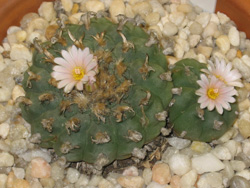
MagiCactus.com
The
new home of Lophophora Williamsii
and its closest friends
![]()
Growers Notes... New Species or Not??
Lophophora Williamsii
var. Menchaca
Lophophora Williamsii var. Menchaca from the area of Tanque Menchaca Coahuila Mexico. This variation grows predominantly at the bottom of a flat valley. This variety of L. Williamsii has been described by the botanist Bohata as the most perfectly formed of the Williamsii family of plants, growing primarily as single headed specimens to over ten centimetres in diameter. From the specimens growing in my collection, I can say that they are definitely unique in appearance, with different qualities than the typical Williamsii variations both in beauty and size.
Seeds of the Menchaca variety germinate easily and this variation has a very high germination rate. The plant grows just as fast as the typical variety if not faster, reaching maturity and offering beautiful flowers that are typically smaller than most variations, with shorter tubes and numerous petals. Within a year and a half of germination. Initially, the first few flowers appear very small and delicate by Williamsii standards but with time, the flowers tend to shoot a little larger, until reaching a point where they resemble the typical flower of two to three centimetres in width. A couple of oddities I have noticed with this variety, are that seed pods don't seem to shoot until the plant is two to three years of age at which time they start popping up all over the place. Most Williamsii varieties on the other hand shoot seed pods within a few weeks of each flower. This is not to say that the first flowers are sterile but simply that they just take a little longer time period before they shoot the hidden seed pod below the dried flower husk. Another interesting factor about the Menchaca variety is its cycle of growth. Side by side with trays of the texana variety, I have seen them grow equally but once the Menchaca variation reaches two years of age it seems to explode with growth, practically doubling its size within a few short months. In fact, pictured side by side with any typical Williamsii variation, it seems to have an extra centimetre or two thick of skin covering it in size. In reality, a typical Williamsii plant such as the texana variation will be five to six centimetres in width while the Menchaca variety will be eight to nine centimetre in diameter as those pictured here below.
Lophophora Williamsii var. Menchaca has proven itself to be self sterile requiring cross pollination to produce seed pods. Bohata has stated that all northern variations are self pollinating so I have some frustrating news for him, and that is that not all northern variations are self pollinating. This has been a tricky thing to follow because it turns out that in the summer tiny flies have tricked me into thinking that these plants were producing fruit on their own. Only after having truly isolated a few of these specimens was I able to find that they are self sterile. Also, I have found it to be a little more rot prone in comparison to some of the other variations. This simply means that the plant takes a little less water than the typical Williamsii variety, which is hard to believe considering the greater size taken on by the plants overall exposed body.
Above: Lophophora Williamsii var. Menchaca
Above: Lophophora Williamsii var. Menchaca cristate
The Lophophora Williamsii var. Menchaca plant above is one of my most favoured seedlings. It originally started life as a true very rare double headed plant, but right from very early on in life one of the heads began with this odd mutation of growing crested or cristate as they say. Normally these plants grow from a single lateral apex at the plants top centre, but when this occurs the apex grows horizontally along a symmetrical line with many different growing points forming somewhat of a fanning appearance which tends to look like a brain of sorts. I have been advised that the plant would hold more value if I was to remove the perfectly formed pup but as a personal plant in my collection I kind of like the two remaining attached as you see them here. Hopefully this plant will flower for me at some point in the future so that I could post some nice photographs here for all to admire.
Here below is a wonderful example of the fruits of my labor with these beautiful plants. This variation of L.W. var menchaca has truly proven itself to be the fastest and largest growing of all variations I have studied. In just under five years of growth from seed the plant pictured below has grown to a whopping 11.2 centimetres in diameter, and 6.5 centimetres in height... truly incredible... I have seventy five year old plants that can't match that. This specimen pictured here does not have any pups but a few of my menchaca variations do which has proven certain botanists thoughts about this variation growing as a single plant wrong. As soon as I am able to take a worthy picture of a specimen with pups I will put it up here below for your pleasure.
Above: Lophophora Williamsii var. Menchaca at almost five years of age and 11.2 centimetres in diameter sporting a complete thirteen ribs... picture perfect plant!! Can you spell show winner!!
email: dr_frank @ magicactus.com
Mailing address:
Frank Valente
MagiCactus.com
56 Dewhurst Blvd.
Toronto, Ontario
M4J 3J3
© 2008, Frank Valente